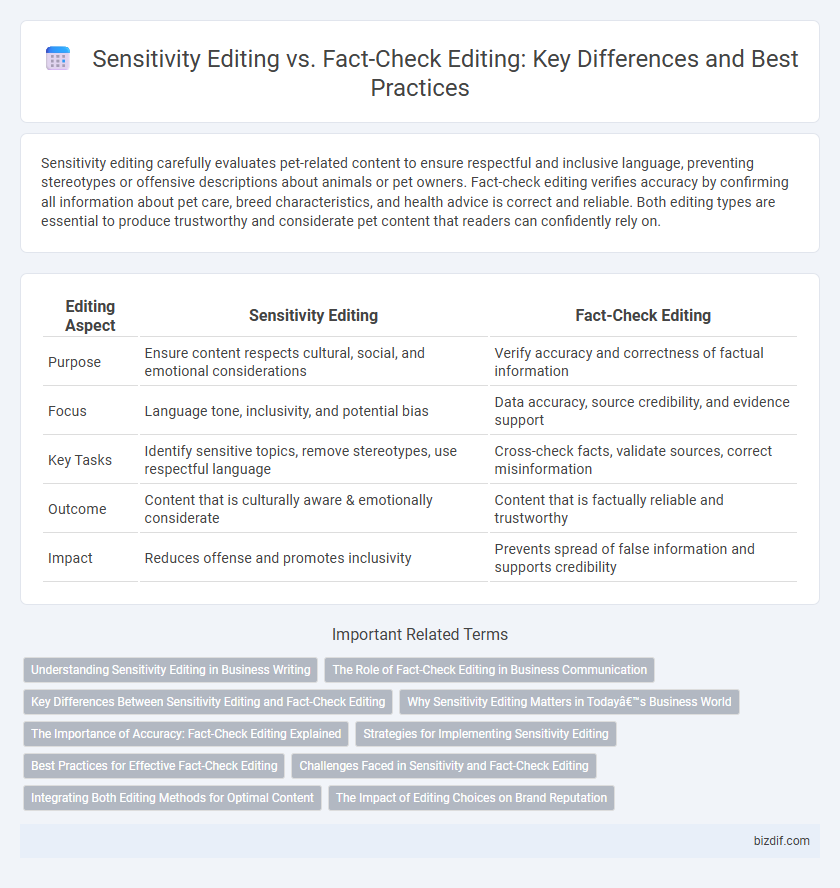Sensitivity editing carefully evaluates pet-related content to ensure respectful and inclusive language, preventing stereotypes or offensive descriptions about animals or pet owners. Fact-check editing verifies accuracy by confirming all information about pet care, breed characteristics, and health advice is correct and reliable. Both editing types are essential to produce trustworthy and considerate pet content that readers can confidently rely on.
Table of Comparison
| Editing Aspect | Sensitivity Editing | Fact-Check Editing |
|---|---|---|
| Purpose | Ensure content respects cultural, social, and emotional considerations | Verify accuracy and correctness of factual information |
| Focus | Language tone, inclusivity, and potential bias | Data accuracy, source credibility, and evidence support |
| Key Tasks | Identify sensitive topics, remove stereotypes, use respectful language | Cross-check facts, validate sources, correct misinformation |
| Outcome | Content that is culturally aware & emotionally considerate | Content that is factually reliable and trustworthy |
| Impact | Reduces offense and promotes inclusivity | Prevents spread of false information and supports credibility |
Understanding Sensitivity Editing in Business Writing
Sensitivity editing in business writing involves carefully reviewing content to ensure it respects diverse cultures, identities, and perspectives, reducing the risk of offending stakeholders and damaging brand reputation. Unlike fact-check editing, which focuses on verifying accuracy and factual correctness, sensitivity editing addresses tone, language, and implications to foster inclusivity and empathy in professional communication. Businesses that prioritize sensitivity editing demonstrate commitment to ethical standards and effective cross-cultural engagement, enhancing trust and credibility in global markets.
The Role of Fact-Check Editing in Business Communication
Fact-check editing ensures the accuracy and credibility of business communication by verifying data, statistics, and claims presented in corporate documents and marketing materials. This type of editing helps prevent misinformation that could damage a company's reputation or lead to legal consequences. By maintaining factual integrity, fact-check editing supports transparent and trustworthy communication between businesses and their stakeholders.
Key Differences Between Sensitivity Editing and Fact-Check Editing
Sensitivity editing involves reviewing content for cultural accuracy, inclusivity, and potential biases to ensure respectful representation of diverse groups. Fact-check editing focuses on verifying the accuracy and reliability of factual information, dates, names, and statistics within the text. The key difference lies in sensitivity editing prioritizing ethical and social considerations, while fact-check editing emphasizes empirical correctness.
Why Sensitivity Editing Matters in Today’s Business World
Sensitivity editing addresses the nuanced representation of diverse groups, preventing unintentional offense and fostering inclusivity in content. Fact-check editing ensures accuracy and credibility by verifying data and statements to maintain trustworthiness. Sensitivity editing matters in today's business world as it enhances brand reputation, promotes cultural competency, and reduces the risk of public backlash in a globally connected marketplace.
The Importance of Accuracy: Fact-Check Editing Explained
Fact-check editing ensures accuracy by verifying all factual claims, dates, names, and statistics within a manuscript to maintain credibility and trustworthiness. Sensitivity editing focuses on cultural, social, and ethical considerations, addressing potential biases or offensive content without altering factual accuracy. Prioritizing fact-check editing preserves the integrity of the content, making it essential for publications that demand precision and reliability in their information.
Strategies for Implementing Sensitivity Editing
Implementing sensitivity editing involves training editors on cultural competence and unconscious bias to ensure content respects diverse perspectives and avoids stereotypes. Developing comprehensive guidelines and checklists tailored to specific communities helps maintain accuracy while promoting inclusivity in narratives. Collaboration with sensitivity readers and subject matter experts ensures that potentially harmful language or concepts are identified and revised thoughtfully.
Best Practices for Effective Fact-Check Editing
Effective fact-check editing involves verifying the accuracy of all data, dates, names, and statistics with reliable sources to maintain content credibility. Sensitivity editing complements this by ensuring the material respects cultural, social, and ethical standards without compromising factual integrity. Combining both practices requires a meticulous review process, clear documentation of sources, and collaboration between editors to enhance the overall quality and trustworthiness of the publication.
Challenges Faced in Sensitivity and Fact-Check Editing
Sensitivity editing involves navigating complex cultural nuances and personal biases, posing challenges in maintaining respectful representation without imposing censorship. Fact-check editing requires rigorous verification of data accuracy, often hindered by limited access to reliable sources and the evolving nature of information. Both editing types demand a delicate balance between ethical responsibility and editorial integrity to ensure content credibility and inclusivity.
Integrating Both Editing Methods for Optimal Content
Sensitivity editing ensures content respects cultural, social, and ethical considerations by identifying potential biases or offensive language, while fact-check editing verifies accuracy and reliability of information through thorough source validation. Integrating both methods creates content that is not only accurate but also inclusive and respectful, enhancing credibility and audience trust. Combining sensitivity and fact-check editing fosters well-rounded, responsible communication that meets both ethical standards and factual precision.
The Impact of Editing Choices on Brand Reputation
Sensitivity editing ensures content respects cultural, social, and ethical standards, reducing the risk of offending audiences and preserving brand integrity. Fact-check editing verifies accuracy and credibility, preventing misinformation that can damage trust and reputation. Together, these editorial choices critically influence public perception and uphold a brand's authenticity in a competitive market.
Sensitivity editing vs Fact-check editing Infographic

 bizdif.com
bizdif.com